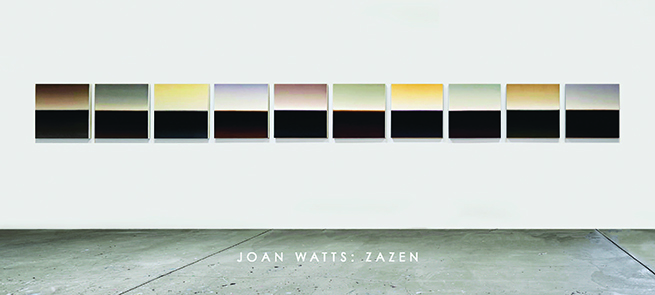
Charlotte Jackson Fine Art is proud to present an exhibition of work, Zazen, by Joan Watts opening on May 31 and extend through June 29. An Opening Reception with the artist will be held on Friday, May 31 from 5-7 p.m. The gallery is located in the Railyard Arts District at 554 South Guadalupe Street.
These colors reach into you. Pierce the sternum, fill the solar plexus, root in the gut. Jewel-toned maroon, shadowed forest green, cool wet slate, warm turned earth, heart-of-iris purple, deepest navy sky: these rich and saturated colors anchor and ground the bottom halves of a series of square-format paintings. Rising from these fertile beds of redolent color blooms a collection of pale contrasting tones: petal yellow, sage green, fog, and topaz, palest aquamarine.
The series of paintings by Joan Watts, Zazen, included in this eponymous exhibition was featured in an exhibition in Wiesbaden, Germany at Galerie Ulrike Buschlinger in the late 1990’s and has never before been shown in the United States.
There are so many ways to approach the series: the pared down visual vocabulary; the square format; the minimal colors. The tonality of those colors and the intricate and painstaking layers of paint used to create the complex and yet simple surfaces. The soft white horizontal line created by grouping several of the individual paintings together. Each viewpoint reveals a facet of these works. But the viewer must go further, and ultimately inward, to join these facets together and see the series holistically.
While it is tempting to see horizons – with the paintings’ darker toned bottom halves rising to light colors above, the title of the series and familiarity with the work of Joan Watts (as well as the square format) suggest another direction altogether. By the late 90’s, Watts had been studying Buddhism for about a decade and by that time the practice had thoroughly shifted and influenced her artistic process. These pieces, as the title suggests, focus particularly on the primary, essential practice of Buddhism: zazen, or sitting meditation. So rather than landscapes, these pieces move the viewer from macrocosm to microcosm, from outward to inward, from distance to closeness.
With this perspective, the squareness accentuates a sense of balance – the feeling of solidity that might come from sitting still upon the earth. The darker tones and colors: body. The lighter colors: mind. Moving through the gallery, piece to piece, that initial impression of the colors rooting down into the gut makes sense. Moving between the darker and lighter halves we begin to intuit a common paradox of Buddhist theory and practice – the simultaneous coexistence of discipline and freedom, of being and nothingness, of solidity and intangibility, of structure and fluidity. Like other Buddhist art forms, Watt’s work exemplifies this dichotomy through a balancing of the qualities of precision and structure with a flowing and intuitive expression.
Now we can stand (or sit) with Watt’s paintings and experience them on their own ground. Root our feet. Take a breath. Aha! We can feel how that mysterious white line, balancing between dark and light, negotiating between dense and diaphanous, might just be breath, the joining of inside and outside. We can walk from piece to piece and feel how each individual painting shows the slightly different experience of Zazen. One day thoughts lead one way. Another day, memories arise. Yet another come emotions of sadness or joy. Another paradox. While the practice remains the same: sit, breathe – the experience is always a slightly different color.
In this way the small works on paper add one additional element to the whole. These tiny pieces feel like fragments, glimpses, bits of thought or imagery. They show glowing lines, fragments of larger layers and geometries. Taken in the context of the whole, of this experiential exhibition of Zazen – these little pieces appear like the bits of thought that can arise during meditation: the fragments of an idea or memory, the flicker of a color or feeling.
Take time here with Zazen. Breathe with each piece. Allow them to guide you.
– Michaela Kahn, Ph.D.

